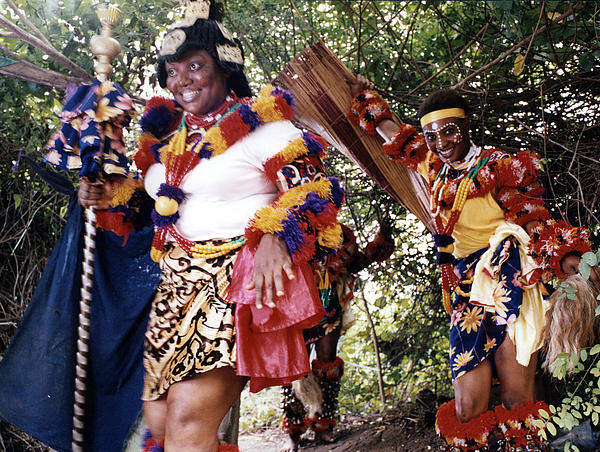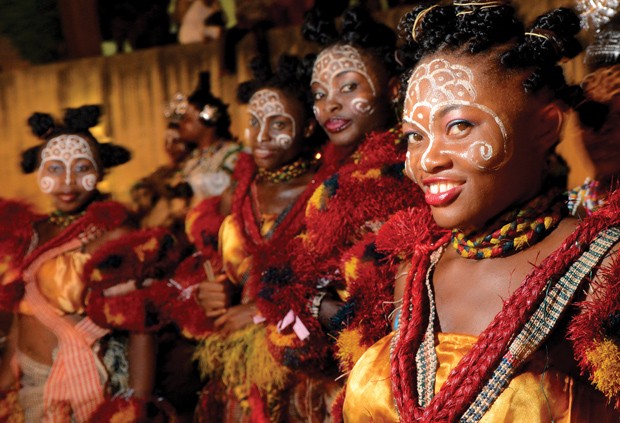Walk up to the young, Westernised bachelor in any of Nigeria’s big cities and ask him if bigger is better in choice of a bride. You’ll most probably get that quizzical stare and a coy smile that give you the sneaky feeling that your question is – well – silly (Hellooo! At least, you do sometimes watch beauty pageants, don’t you?). So, very likely your poll result would be: the modern African bride must be slim, curvy, and graceful; very much like an Agbani Darego, Oluchi Orlandi, Genevive Nnaji or a Tiwa Savage.
But all that runs against the grain in the Efik tradition. Here, the pride of the groom is an obese bride just emerging from a fattening room; where she is subjected to an incredible six months session of no-work-and-all-food-and-sleep! So is bigger the better, according to this curious African marriage rite?
Among the Efik, domiciled in large parts of Akwa Ibom and Cross River States, beauty is not always in the eyes of the beholder; but as defined by the fattening room marriage rites of the people.
In this culture, the men are conditioned to have a preference for round, fat, overweight women which in their eyes is the epitome of beauty and symbol of desire, prosperity, wealth, homeliness, motherliness and virtue. Sometime easier pregnancy and fertility are associated with obese women, making the fattening room culture an important aspect of Efik culture and tradition.
Big is Beautiful
In contrast, slim women are seen as unhealthy, unfed and likely to have difficulty bearing children; and men who prefer them looked down on as tasteless, poor, too Westernised and, ultimately, un-African.
Although as a result of modernity as well as the well-known health problems connected to obesity, the cultural practice of fattening room is not as rampant in that part of Nigeria as before, some African societies still view being fat as a symbol of status and power. In fact, some rich grooms or families pay for special "fattening rooms" for their bride to put on extra weight.
Ethnic interpretations of what constitutes beauty in a woman aside, medical experts often warn that obesity comes with many negative attributes which are all health related like coronary heart disease, blocking and narrowing the arteries, high blood pressure, Type 2 diabetes, abnormal blood fat, metabolic problems and even early death through stroke.
But like all entrenched cultural practices, the Efik have their own compelling arguments why the curious marriage rites of the fattening room is a very important traditional and cultural event that symbolises wealth, prosperity, good fortune and beauty by the bride to her husband.
‘All Play and No Work’
The bride is subjected to seclusion for a long period – ranging from three months, six months to an entire year – and fed a large quantity of rich fatty food daily and allowed lots of sleep so she can gain excess weight and become obese. After the rites, your bride of just about 60kg will be well over twice that.
The foods the woman is forced to consume in large qualities, even when she has no appetite, are usually rich native delicacies loaded with calories like Ekpan Koko, Edika Ikong, Afang generously filled with snail, bush meat and fish, as well as meals consisting yam, rice, beans, cassava, and wheat.
The woman’s entry into and eventual emergence from the fattening room is characterised by funfair celebrations and excitement. She is attired in traditional outfits, beautified in finery, colourful materials, beads around the waist, hair properly woven in cornrows and bangles on ankle and wrists. She may also be painted in earthy colours all over the body.
The isolation of the bride also means she gets no visitors either male or female (except minders) and is restricted to her immediate environment which could be a bungalow, hut, or small compound. Although, in modern times she may have a few home comforts to compensate for a likely feeling of boredom or loneliness. She may also be allowed to relish the taste of palm wine, undergo massages, spa and body treatment, stretching, rubbing of lotions, use of herbal concoctions and oils on the body.
But besides fattening her up for her would-be husband’s pleasure, the bride is taught other cultural traditions of her people by her minders, who are usually elderly women.
This includes certain traditional wifely duties and expectations like how to cook some native dishes and properly care for her new family. She may also learn some traditional songs and oral traditions and be tutored in traditional art and crafts, manage funds and ultimately please her husband.
Waning Tradition

In the olden days, sometimes a more sinister purpose like circumcision is carried during the fattening room rites as it was erroneously believed to aid child birth and reduce the likelihood of promiscuity. In more modern fattening room practices, this particular function is banned and long forgotten.
As glamorised as it may look, in the past the fattening room was not a journey to blissful pampering, indulgence, and sumptuous meals. In reality, the rite was tough, frightening, and forced on the woman. Thankfully, in modern times it is no longer compulsory. Only those bound by a need for tradition and the rich with a compulsive itch to be acknowledged as wealthy and healthy still carry out this Tradition

But all that runs against the grain in the Efik tradition. Here, the pride of the groom is an obese bride just emerging from a fattening room; where she is subjected to an incredible six months session of no-work-and-all-food-and-sleep! So is bigger the better, according to this curious African marriage rite?
Among the Efik, domiciled in large parts of Akwa Ibom and Cross River States, beauty is not always in the eyes of the beholder; but as defined by the fattening room marriage rites of the people.
In this culture, the men are conditioned to have a preference for round, fat, overweight women which in their eyes is the epitome of beauty and symbol of desire, prosperity, wealth, homeliness, motherliness and virtue. Sometime easier pregnancy and fertility are associated with obese women, making the fattening room culture an important aspect of Efik culture and tradition.
Big is Beautiful
In contrast, slim women are seen as unhealthy, unfed and likely to have difficulty bearing children; and men who prefer them looked down on as tasteless, poor, too Westernised and, ultimately, un-African.
Although as a result of modernity as well as the well-known health problems connected to obesity, the cultural practice of fattening room is not as rampant in that part of Nigeria as before, some African societies still view being fat as a symbol of status and power. In fact, some rich grooms or families pay for special "fattening rooms" for their bride to put on extra weight.
Ethnic interpretations of what constitutes beauty in a woman aside, medical experts often warn that obesity comes with many negative attributes which are all health related like coronary heart disease, blocking and narrowing the arteries, high blood pressure, Type 2 diabetes, abnormal blood fat, metabolic problems and even early death through stroke.
But like all entrenched cultural practices, the Efik have their own compelling arguments why the curious marriage rites of the fattening room is a very important traditional and cultural event that symbolises wealth, prosperity, good fortune and beauty by the bride to her husband.
‘All Play and No Work’
The bride is subjected to seclusion for a long period – ranging from three months, six months to an entire year – and fed a large quantity of rich fatty food daily and allowed lots of sleep so she can gain excess weight and become obese. After the rites, your bride of just about 60kg will be well over twice that.
The foods the woman is forced to consume in large qualities, even when she has no appetite, are usually rich native delicacies loaded with calories like Ekpan Koko, Edika Ikong, Afang generously filled with snail, bush meat and fish, as well as meals consisting yam, rice, beans, cassava, and wheat.
The woman’s entry into and eventual emergence from the fattening room is characterised by funfair celebrations and excitement. She is attired in traditional outfits, beautified in finery, colourful materials, beads around the waist, hair properly woven in cornrows and bangles on ankle and wrists. She may also be painted in earthy colours all over the body.
The isolation of the bride also means she gets no visitors either male or female (except minders) and is restricted to her immediate environment which could be a bungalow, hut, or small compound. Although, in modern times she may have a few home comforts to compensate for a likely feeling of boredom or loneliness. She may also be allowed to relish the taste of palm wine, undergo massages, spa and body treatment, stretching, rubbing of lotions, use of herbal concoctions and oils on the body.
But besides fattening her up for her would-be husband’s pleasure, the bride is taught other cultural traditions of her people by her minders, who are usually elderly women.
This includes certain traditional wifely duties and expectations like how to cook some native dishes and properly care for her new family. She may also learn some traditional songs and oral traditions and be tutored in traditional art and crafts, manage funds and ultimately please her husband.
Waning Tradition
In the olden days, sometimes a more sinister purpose like circumcision is carried during the fattening room rites as it was erroneously believed to aid child birth and reduce the likelihood of promiscuity. In more modern fattening room practices, this particular function is banned and long forgotten.
As glamorised as it may look, in the past the fattening room was not a journey to blissful pampering, indulgence, and sumptuous meals. In reality, the rite was tough, frightening, and forced on the woman. Thankfully, in modern times it is no longer compulsory. Only those bound by a need for tradition and the rich with a compulsive itch to be acknowledged as wealthy and healthy still carry out this Tradition


No comments:
Post a Comment
WE LOVE COMMENTS, POST A COMMENT